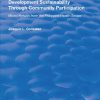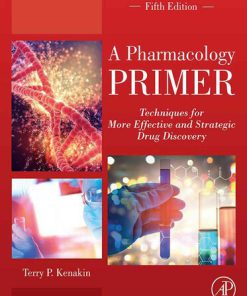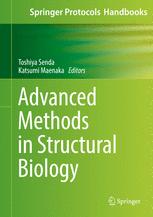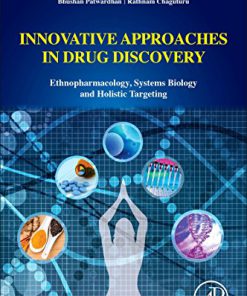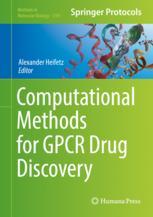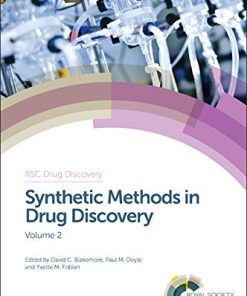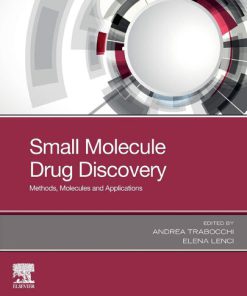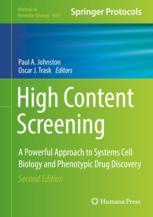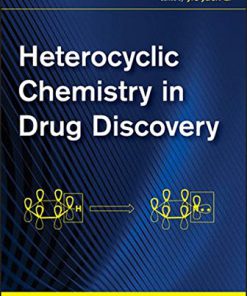Structural Biology in Drug Discovery Methods Techniques and Practices 1st Edition by Jean Paul Renaud ISBN 1118681010 9781118681015
$50.00 Original price was: $50.00.$25.00Current price is: $25.00.
Structural Biology in Drug Discovery Methods Techniques and Practices 1st Edition by Jean-Paul Renaud – Ebook PDF Instant Download/Delivery: 1118681010, 978-1118681015
Full download Structural Biology in Drug Discovery Methods Techniques and Practices 1st Edition after payment
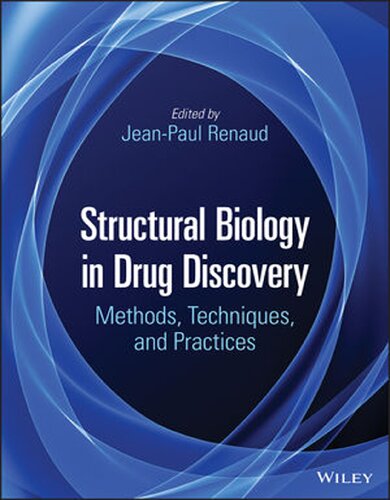
Product details:
ISBN 10: 1118681010
ISBN 13: 978-1118681015
Author: Jean Paul Renaud
With the most comprehensive and up-to-date overview of structure-based drug discovery covering both experimental and computational approaches, Structural Biology in Drug Discovery: Methods, Techniques, and Practices describes principles, methods, applications, and emerging paradigms of structural biology as a tool for more efficient drug development. Coverage includes successful examples, academic and industry insights, novel concepts, and advances in a rapidly evolving field.
The combined chapters, by authors writing from the frontlines of structural biology and drug discovery, give readers a valuable reference and resource that:
- Presents the benefits, limitations, and potentiality of major techniques in the field such as X-ray crystallography, NMR, neutron crystallography, cryo-EM, mass spectrometry and other biophysical techniques, and computational structural biology
- Includes detailed chapters on druggability, allostery, complementary use of thermodynamic and kinetic information, and powerful approaches such as structural chemogenomics and fragment-based drug design
- Emphasizes the need for the in-depth biophysical characterization of protein targets as well as of therapeutic proteins, and for a thorough quality assessment of experimental structures
- Illustrates advances in the field of established therapeutic targets like kinases, serine proteinases, GPCRs, and epigenetic proteins, and of more challenging ones like protein-protein interactions and intrinsically disordered proteins
Structural Biology in Drug Discovery Methods Techniques and Practices 1st Table of contents:
Part I: Overview, Concepts, and Approaches
1. The Evolving Role of Structural Biology in Drug Discovery
- 1.1 Introduction
- 1.2 The Expanding Toolbox of Structural Biology for Drug Discovery
- 1.3 The Various Uses of Structural Biology in Drug Discovery
- 1.4 Evolving Drugs and Targets
- 1.5 Current Trends and Perspectives
- References
2. A Structural View on Druggability: Experimental and Computational Approaches
- 2.1 Introduction
- 2.2 Views on Target Druggability
- 2.3 In Silico Methods for Druggability Assessment of Targets with Well-Defined Pockets
- 2.4 Experimental Methods for Druggability Assessment
- 2.5 A Challenge for Druggability Predictions: Protein–Protein Interactions
- 2.6 Perspective
- References
3. Structural Chemogenomics: Profiling Protein–Ligand Interactions in Polypharmacological Space
- 3.1 Introduction
- 3.2 Simultaneously Targeting Multiple Proteins Can Be More Efficient in Disrupting Disease Mechanism
- 3.3 Computer-Aided Approaches for Profiling Bioactivities of Ligands
- 3.4 Applications
- 3.5 Conclusion
- References
4. Fragment-Based Ligand Discovery
- 4.1 Introduction
- 4.2 The Evolution of FBLD
- 4.3 The FBLD Process
- 4.4 Fragment Libraries
- 4.5 Maintaining a Fragment Library
- 4.6 Fragment Screening
- 4.7 Integrating Fragments with Other Compounds
- 4.8 Validating Fragment Hits: Comparing Methods
- 4.9 Fragment Hit Rates
- 4.10 Determining Structures of Fragment: Protein Complexes
- 4.11 Fragment Evolution
- 4.12 Concluding Remarks
- Acknowledgments
- References
5. Combining Structural, Thermodynamic, and Kinetic Information to Drive Hit-to-Lead Progression
- 5.1 Introduction
- 5.2 The Role of Thermodynamics in Hit to Lead
- 5.3 The Role of Kinetics in Hit to Lead
- 5.4 Summary
- References
6. Allostery as Structure-Encoded Collective Dynamics: Significance in Drug Design
- 6.1 Introduction
- 6.2 Computational Methods
- 6.3 Applications
- 6.4 Future Directions and Conclusion
- References
Part II: Tool
7. Biophysical Assessment of Target Protein Quality in Structure-Based Drug Discovery
- 7.1 Biophysical Methods in Drug Discovery
- 7.2 Case Study I: Micro-Inhomogeneity
- 7.3 The Role of Biophysical Methods in the Optimization of Protein Crystallization
- 7.4 Case Study II: Minimizing Macro-Inhomogeneity
- 7.5 Outlook and Concluding Remarks: Requirements for Upcoming Biophysical Methods
- Acknowledgment
- References
8. An Industrial Perspective on Protein–Ligand Complex Crystallization
- 8.1 Introduction to Co-Crystal Structures and Drug Development
- 8.2 Basics of X-Ray Analysis of Co-Crystals
- 8.3 Ligands
- 8.4 Preparing Protein for Successful Crystallization
- 8.5 Crystallization
- 8.6 Selecting Ligands for Crystallization
- 8.7 Methods for Obtaining Co-Crystals: Soaking and Co-Crystallization
- 8.8 Future Perspective
- Acknowledgment
- References
9. Membrane Protein Crystallization
- 9.1 Introduction
- 9.2 Membrane Protein Production
- 9.3 Amphipathic Manipulation of Membrane Proteins
- 9.4 Preparing Protein Samples for Crystallization
- 9.5 Membrane Protein Crystallization
- 9.6 Methods for Determining Membrane Protein Structures
- 9.7 Conclusion and Outlooks
- References
10. High-Throughput Macromolecular Crystallography in Drug Discovery: Evolving in the Midst of Revolutions
- 10.1 Introduction
- 10.2 Setting the Scene for Evolution and Revolutions
- 10.3 Baseline: The “Human, All Too Human” Workflow of Early MX for SBDD
- 10.4 First Wave of Automation Toward High-Throughput Operation: Robotics Without Refactoring
- 10.5 Second Wave of Automation: The Twin Tracks of In Situ Crystallography and Microcrystallography
- 10.6 An Emerging Third Wave of Automation: Serial Microcrystallography
- 10.7 From Diffraction Data to Structural Results: Evolving Best Practices
- 10.8 Conclusions and Outlook: Whither HTMX for Drug Discovery?
- Acknowledgments
- References
11. Assessment of Crystallographic Structure Quality and Protein–Ligand Complex Structure Validation
- 11.1 Introduction
- 11.2 Quality Parameters
- 11.3 Dataset Quality
- 11.4 Low-Resolution Structures
- 11.5 Possible Influence of Crystal Packing
- 11.6 Software Tools
- 11.7 Analysis of Quality Metrics
- 11.8 Conclusions
- Acknowledgments
- References
12. Complementary Information from Neutron Crystallography Studies
- 12.1 Introduction
- 12.2 Differences in Characteristics of X-Rays and Neutrons
- 12.3 A Brief History of Protein Neutron Crystallography
- 12.4 Facility, Neutron Source, and Detector
- 12.5 Current Status of Neutron Protein Crystallography
- 12.6 Method for Neutron Crystallography of Proteins
- 12.7 General Information Obtained from Neutron Crystallography
- 12.8 Use of Neutron Crystallography for the Structure Analysis of Protein Drug Targets
- 12.9 Use of Neutron Protein Crystallography for Drug Design
- 12.10 Future Perspectives of the Use of Neutron Crystallography for Drug Design
- References
13. Determination of Protein Structure and Dynamics by NMR: State of the Art and Application to the Characterization of Biotherapeutics
- 13.1 Introduction
- 13.2 Solution Structure Determination of Macromolecules by NMR
- 13.3 Assignment and Labeling Strategies
- 13.4 NMR and Dynamic Aspects
- 13.5 Biomolecular Dynamics by NMR
- 13.6 Intrinsically Disordered Proteins
- 13.7 Alternative Approaches for Non-Soluble Proteins
- 13.8 Optimized Strategies for the Study of Biomolecules in Solution
- 13.9 Conclusion
- References
14. NMR Studies of Protein–Small Molecule Interactions for Drug Discovery
- 14.1 Introduction
- 14.2 Early-Stage Discovery
- 14.3 Lead Optimization
- 14.4 Emerging Applications/Fields
- 14.5 Outlook
- References
15. Computational Structural Biology for Drug Discovery: Power and Limitations
- 15.1 Introduction
- 15.2 Converting PDB Entries into Full-Atom Models
- 15.5 Future Perspective
- Acknowledgments
- References
Part III: Structure-Based Discovery in Some Important or Promising Targets and Therapeutic Families
16. The Role of Structural Biology in Kinase Inhibitor Drug Discovery Success
- 16.1 Protein Kinases and Their Structural Elements: A Dynamic Landscape for Drug Discovery
- 16.2 The Challenge of Selectivity and Drug Resistance: Design and Discovery of Afatinib, the First Irreversible Protein Kinase Inhibitor Approved for Cancer Treatment
- 16.3 When Structural Biology Drives Chemistry to Therapeutic Breakthrough: The Vemurafenib Case History
- 16.4 Second-Generation Anaplastic Lymphoma Kinase Inhibitors: The Discovery of the First-in-Class Drug Ceritinib
- 16.5 The Discovery of Type II Inhibitor Ponatinib: A Milestone in the Struggle Against the ABL Gatekeeper Resistant Mutation T315I
- 16.6 Protein Kinase Inhibitor Drug Discovery and Structural Biology: Future Perspective
- References
17. Serine Proteinases from the Blood Coagulation Cascade
- 17.1 Introduction
- 17.2 Thrombin
- 17.3 Factor Xa (FXa)
- 17.4 Factor VIIa (FVIIa)
- 17.5 Further Developments
- 17.6 Factor IXa
- 17.7 Factor XIa
- 17.8 Impact of Structure-Based Drug Design
- References
18. Epigenetic Proteins as Emerging Drug Targets
- 18.1 Introduction
- 18.2 Acetylation/Deacetylation
- 18.3 Methylation/Demethylation
- 18.4 Other Epigenetic Modifications
- 18.5 The Future of Epigenetic Drug Discovery
- Acknowledgments
- References
19. Impact of Recently Determined Crystallographic Structures of GPCRs on Drug Discovery
- 19.1 G Protein-Coupled Receptors as Pharmaceutical Targets
- 19.2 Topology and Classes of GPCRs
- 19.3 GPCR X-Ray Crystal Structures
- 19.4 Class A GPCR Small Ligand Binding Sites and Druggability
- 19.5 Class B GPCR X-Ray Crystal Structures
- 19.6 Class C GPCRs and Allosteric Modulators
- 19.7 GPCR Activation
- 19.8 Structure-Based Approaches to GPCR Drug Discovery
- 19.9 Conclusion
- References
20. Targeting Protein–Protein Interactions Perspective
- 20.1 Introduction
- 20.2 Detection and Analysis of PPIs
- 20.3 PPI Screening
- 20.4 Examples
- 20.5 Stapled Peptides
- 20.6 Alternatives to Small-Molecule Orthosteric Inhibition
- 20.7 Conclusion and Perspectives
- References
21. Mass Spectrometry-Based Strategies for Therapeutic Antibodies Extensive Characterization and Optimization (OptimAbs)
- 21.1 Introduction
- 21.2 Intact mAb Analysis
- 21.3 Middle-Up mAb Analysis
- 21.4 Bottom-Up Peptide Mapping for Primary Structure Assessment
- 21.5 Top-Down Approaches for mAb Sequencing
- 21.6 Hydrogen/Deuterium Exchange Mass Spectrometry
- 21.7 Native MS and Ion Mobility-Mass Spectrometry (IM-MS) for the Characterization of mAb/Ag Binding Stoichiometry and of Protein Conformation
- 21.8 From Optimized Antibodies (OptimAbs) to Optimized Antibody-Drug Conjugates (OptimADCs)
- 21.9 Concluding Remarks
- Acknowledgments
- References
Part IV: Challenges and New Frontiers
22. Integrating Evolution of Drug Resistance into Drug Discovery: Lessons from the Viral Proteases of HIV-1 and HCV
- 22.1 Evolution of Antiviral Drug Resistance
- 22.2 Substrate Envelope in Drug Design
- 22.3 Protein Dynamics Is Key to Molecular Recognition
- 22.4 Robust Drug Design: Hitting Multiple Targets at a Time
- 22.5 Future Perspective: Integrating Evolution and Conformational Dynamics into Drug Design
- Acknowledgments
- References
23. A Comprehensive Review on Mycobacterium tuberculosis Targets and Drug Development from a Structural Perspective
- 23.1 Introduction
- 23.2 Tuberculosis
- 23.3 Mycobacterium tuberculosis
- 23.4 Tuberculosis Drug Discovery and Development
- 23.5 Conclusion and Perspectives
- References
24. Using Crystal Structures of Drug-Metabolizing Enzymes in Mechanism-Based Modeling for Drug Design
- 24.1 Structure-Based Modeling of Cytochrome P450s
- 24.2 Other Phase I Drug-Metabolizing Enzymes
- 24.3 Phase II Drug-Metabolizing Enzymes
- 24.4 Interplay Between Metabolism and Inhibition
- 24.5 Future Directions
- Acknowledgment
- References
25. Intrinsically Disordered Proteins: Targets for the Future?
- 25.1 Introduction
- 25.2 IDPs as Novel Drug Targets
- 25.3 Molecular Mechanisms of Drugs Targeting Ordered Proteins
- 25.4 Disorder-Based Rational Drug Design
- 25.5 Direct Targeting of IDPs/IDPRs
- 25.6 Targeting Functionally Misfolded IDPs: A Hypothesis
- 25.7 Targeting Intrinsically Disordered Structural Ensembles: α-Synuclein as an Illustration
- 25.8 Targeting Aggregating IDPs
- 25.9 Conclusions
- Acknowledgments
- References
26. Cryo-Electron Microscopy as a Tool for Drug Discovery in the Context of Integrative Structural Biology
- 26.1 Introduction
- 26.2 The Resolution Revolution
- 26.3 What Is Cryo-EM?
- 26.4 The Cryo-EM Single-Particle Analysis Workflow
- 26.5 Selected Case Studies
- 26.6 Summary and Conclusion
- References
27. Application of Hard-X-Ray Free-Electron Lasers for Static and Dynamic Processes in Structural Biology
- 27.1 Introduction: Overview of X-Ray Free-Electron Lasers
- 27.2 Comparison with Conventional X-Ray Crystallography
- 27.3 XFEL Structures: Successes Since 2009
- 27.4 Challenges in XFELs
- 27.5 Future Outlook
- 27.6 Conclusion
People also search for Structural Biology in Drug Discovery Methods Techniques and Practices 1st:
role of structural biology in drug discovery
structural biology in drug discovery and development
what does structural mean in biology
a drug is structurally similar to paba
what is the function of structure d
Tags:
Jean Paul Renaud,Structural,Biology,Drug,Discovery,Methods,Techniques,Practices 1st
You may also like…
Biology and other natural sciences - Molecular
Computational Methods for GPCR Drug Discovery 1st Edition Alexander Heifetz 1493984942 9781493984947
Biology and other natural sciences
Biology and other natural sciences
Science (General)



